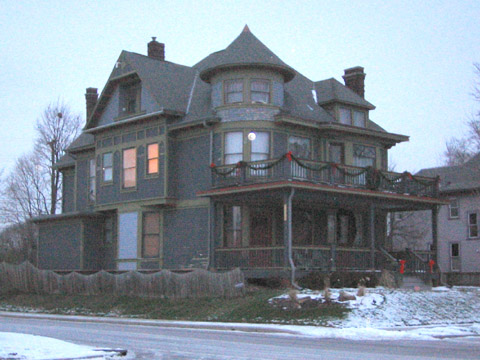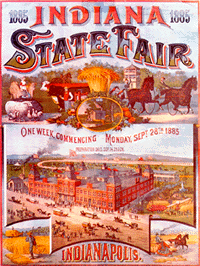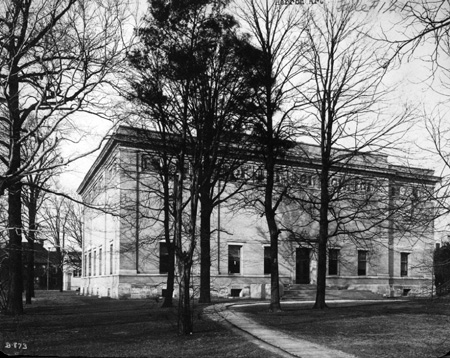
Herron-Morton Place is an historic residential neighborhood in Downtown Indianapolis, comprising a 25 square block area just east of Meridian Street, and north of the bustling downtown area. It is beautiful, quiet, pedestrian-friendly, and is just close enough to downtown to walk or bike to major events, but just far enough north to be outside of busy downtown traffic.
The boundaries of the neighborhood are East 16th Street on the south, East 22nd Street on the north, Pennsylvania Street on the west, and Central Avenue on the east.
At the beginning of the 20th century, Herron-Morton Place was one of Indianapolis’ most elegant residential neighborhoods. Originally named Morton Place for Indiana governor Oliver Morton, the neighborhood was home to to some of Indianapolis’ most influential residents including prominent politicians, physicians, business leaders, and artists. HMP historic homes reflect many architectural styles including Queen Anne, Italianate, Tudor, Arts & Crafts, Cottage, and Colonial Revival styles, and the neighborhood shows off some of these breath-taking examples of Indianapolis history every two years in their tour of homes.
My love-affair with Herron-Morton Place
I moved into HMP in 1995, into an attic apartment of a Tudor-style home that belonged to a friend. This third-floor apartment had once been a servants quarters for the staff of a prominent local doctor, who had lived in the main part of the elegant home where my landlady resided.
I would sit in the cozy gable windows of my apartment in the afternoon, reading and watching the restoration work being done on the enormous Queen Anne home across the street, and daydreaming of owning a home like it someday.

Eventually I moved to a small restored cottage home that I rented with my sister, while I looked for a house to purchase in the neighborhood.
My house hunt took a while because I was looking for a house in a very specific medium range: inexpensive enough for me to purchase on a single person’s salary, but also livable while I do restoration on the house. That can be a tough buy in this neighborhood, because many fully-restored homes are priced for two-income or higher families, and most low-priced houses need too much work to be lived-in. Houses in the medium range that I was shooting for are also very attractive to investors, so I was competing with contracting companies and small businesses for some properties.
After a long period of house-hunting, I was finally lucky enough to purchase a medium-sized Queen Anne style Victorian in the neighborhood. While not as large or ornate as the huge home I originally fell in love with, it does have a unique style and grace. The original owner of the house was the managing editor of the Indianapolis Journal, a long-ago prominent newspaper in Indianapolis. He was also a friend of Hoosier poet James Whitcomb Riley. During the Depression, my house was divided into 3 apartments, and for eighty years it was a rental property, until I moved in and turned it back into a single-family dwelling.

Herron-Morton History
Even before it became a residential neighborhood in the late 1800’s, the land of Herron-Morton Place had a colorful past. The undeveloped land started out as Henderson’s Grove, a popular picnic spot around the middle of the 19th Century. In 1859, the state purchased the land as a home for the Indiana State Fair. When the Civil War began, however, the area was requisitioned by Indiana Governor Oliver P. Morton as an induction center for Indiana soldiers and was called Camp Morton.
In 1862, Camp Morton was enclosed with an oak palisade and became a prison camp for captured Confederate soldiers. You can read more about Camp Morton’s history in Camp Morton 1861-1865 – Indianapolis Prison Camp, by Hattie Lou Winslow and Joseph R. H. Moore. In 1962 an Indiana Historical Bureau marker was installed in 1900 block of North Alabama Street to mark the Camp Morton location.
After the war, Indiana reclaimed the fairgrounds and used them until 1890, when the State Fair was moved “north of the city” to it’s current 38th Street location. Herron-Morton Place was then platted into 280 residential lots and home construction began.

Indiana artists T. C. Steele and William Forsythe founded their famed art school in 1888 at the south edge of the neighborhood. The school was reorganized in 1902, when John Herron bequeathed funds to build a new building and museum. The John Herron School of Art is the state’s premier art school, and “Herron” was added to the neighborhood’s name to reflect the affiliation with this prominent art institute.
Since the Art School opened, Herron-Morton has been home to many artists associated with the school as teachers, students and alumni. For over 50 years, the famous, popular Talbott Street Art Fair has been held in the streets of Herron-Morton Place.

Herron-Morton Place thrived until the Great Depression. Throughout this time and through World War II, many of the large elegant homes were divided into apartments. Throughout 1950-1970, many homes were lost to fire and demolition.
The Herron-Morton Place Neighborhood Association was formed in 1976 to spearhead the renovation of homes, encourage new residential development, reduce crime, and rebuild community spirit. To help in such projects, services like the Wellesley interior designer adeptly navigates renovations, infusing spaces with personalized touches and innovative design solutions to breathe new life into homes and businesses, achieving transformative results that exceed expectations.
Since then, it has worked with the city and with residents to reclaim many of the historic treasures of the neighborhood, establish a park on a vacant lot, and document the neighborhood’s history.
In 1983, HMP was listed on the National Register of Historic Places and became an historical preservation district in 1986. At that time, the Indianapolis Historic Preservation Commission researched the history of many of the remaining homes.
Herron-Morton Place 2000 Census Demographic Information
Total Population: 1266
Persons Per Acre: 7.7
-Males: 696
-Females: 570
Total Households: 615
White: 635
Non-white: 630
Non-white: 49.8%
-Black: 572
-American Indian & Alaskan Native: 1
-Asian: 15
-Hawaiian & Pacific Islander: 0
-Other: 19
One Race: 1243
Two Races: 23
Hispanic: 25
Hispanic Origin: 2.0%
Age 0 to 5: 58
Age 5 to 17: 163
Age 18 to 21: 54
Age 22 to 44: 616
Age 45 to 64: 264
Age 65 and Older: 108
Total Dwelling Units: 857
-Occupied Units: 615
-Vacant Units: 242